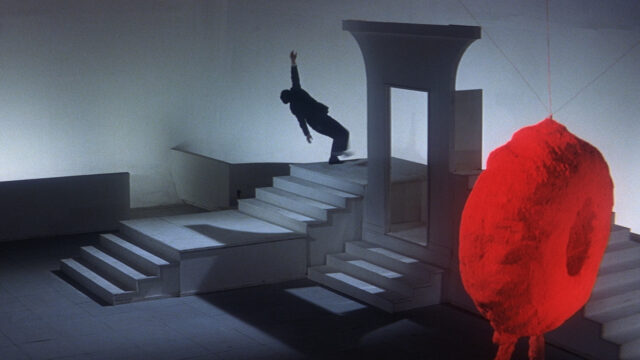
Tokyo Drifter is part of six-film Japan Society tribute to master filmmaker Seijun Suzuki
SEIJUN SUZUKI CENTENNIAL
Japan Society
333 East 47th St. at First Ave.
February 3-11, $15
japansociety.org
“I am often told that a script with a dark subject always turns into a more cheerful movie in my hands,” master Japanese filmmaker Seijun Suzuki says in a brief Criterion “Suzuki on Suzuki” video interview. “Maybe it is due to my personality that I dislike dark stories. I always start by thinking about the style and design of the film. I choose the costumes and sets based on that initial image. Rather than using the same color, isn’t if more fun if each scene is a different color?”
Suzuki’s 1966 yakuza yarn, Tokyo Drifter, is a prime example of his philosophy of cinema, a berserk noir screening February 4 in the Japan Society tribute “Seijun Suzuki Centennial,” honoring the Tokyo-born director of more than fifty films between 1956 and 2005; Suzuki died in February 2017 at the age of ninety-three.
Tokyo Drifter must be seen on the big screen to be fully appreciated. Nearly every set is an eye-popping work of art, courtesy of production designer Takeo Kimura, and lushly photographed by cinematographer Shigeyoshi Mine. Black-and-white morphs into bold and brash reds, yellows, and blues for no reason. Backgrounds disappear so it looks like a shootout is taking place in a black void. A statue of a woman holding some kind of prehistoric giant donut switches hues as the action continues around it. Our hero, whose blazer goes from powder blue to yellow to cream to white, turns a corner and is suddenly running down a heavenly white German expressionist passageway. A villain uses his black gun to dial on a red phone. Hajime Kaburagi’s jazzy noir score mixes with romantic ballads, complete with a man in black playing a white piano. Red blood squirts into the air. Shinya Inoue’s editing is inconsistent and choppy, adding to the derangement, whether done on purpose or not.
Suave Tetsu “Phoenix” Hondo (Tetsuya Watari) and his boss, Kurata (Ryūji Kita), are getting out of the yakuza game, but Otsuka (Hideaki Esumi) and his gang, including Tatsu “the Viper” (Tamio Kawaji), are not going to let it be easy for them. Kurata owes an important building payment to Keiichi (Tsuyoshi Yoshida), who is willing to make a fair deal, as Kurata does not have all the money. But Otsuka sneaks in and threatens Keiichi to sell to him so Otsuka can take over the immensely valuable property. Kurata’s assistant, Mutsuko (Kaoru Hama), reads comic books and is secretly in cahoots with Otsuka, while Tetsu’s girlfriend, Chiharu (Chieko Matsubara), is a sweet-natured lounge singer who performs in a far-out nightclub. (Watari sings the song over the opening credits.) Double crosses lead to characters questioning loyalty and trust as the body count rises amid a groovy avant-garde Pop art setting unlike any other yakuza flick. (Suzuki followed it up with Tokyo Drifter 2: The Sea Is Bright Red as the Color of Love, a very different kind of film.)
Copresented by the Japan Foundation and guest curated by University of Alberta assistant professor William Carroll, “Seijun Suzuki Centennial” runs February 3-11 and comprises imported 35mm films from throughout Suzuki’s career: the ghost story Kagero-za (1981), the second part of his Taisho Trilogy, which began with 1980’s Zigeunerweisen and concluded with 1991’s Yumeji; a double feature of the director’s first Nikkatsu yakuza thriller, Satan’s Town (1956), and the forty-minute melodrama Love Letter (1958); 1966’s Carmen from Kawachi, one of three Suzuki adaptations of novels by Tôkô Kon; and A Tale of Sorrow and Sadness (1977), about a model turned golf star who faces stress and a stalker, Suzuki’s first film in ten years following a battle with Nikkatsu, which decided it no longer liked his unpredictable work after Branded to Kill.
“As Suzuki worked in a transforming film industry, he experimented with new possibilities given by changes in technology and took up new stylistic trends as they were developed by his colleagues, but he pushed them toward more abstract ends. As a result, Suzuki’s style was a constantly shifting target,” Carroll writes in Suzuki Seijun and Postwar Japanese Cinema. “Ultimately, the Seijunesque is defined less by a singular trait or tendency than by a push-or-pull, direct juxtaposition, or synthesis between multiple tendencies that would seem to be irreconcilable.” All that and more is on view in this tribute to a film icon.